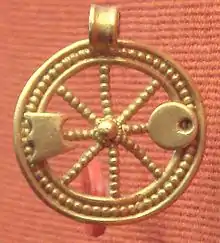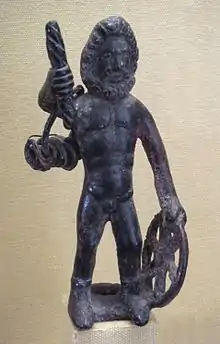Lugus
Lugus was a deity of the Celtic pantheon. His name is rarely directly attested in inscriptions, but his importance can be inferred from place names and ethnonyms, and his nature and attributes are deduced from the distinctive iconography of Gallo-Roman inscriptions to Mercury, who is widely believed to have been identified with Lugus, and from the quasi-mythological narratives involving his later cognates, Welsh Lleu Llaw Gyffes (Lleu of the Skillful Hand) and Irish Lugh Lámhfhada (Lugh of the Long Arm).
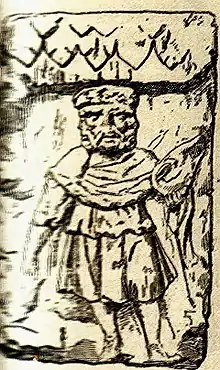
Etymology
The exact etymology of Lugus is unknown and contested. The Proto-Celtic root of the name, *lug-, is generally believed to have been derived from one of several different Proto-Indo-European roots, such as *leug- "black",[2][3] *leuǵ- "to break",[4] and *leugʰ- "to swear an oath".[5] It was once thought that the root may be derived from Proto-Indo-European *leuk- "to shine", but there are difficulties with this etymology and few modern scholars accept it as being possible (notably because Proto-Indo-European *-k- never produced Proto-Celtic *-g-[6]).
Inscriptions
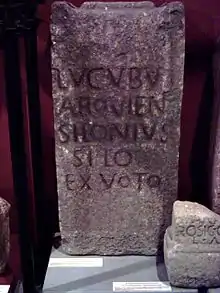
The god Lugus is mentioned in a Celtiberian inscription from Peñalba de Villastar in Spain, which reads:
- ENI OROSEI VTA TICINO TIATVNEI TRECAIAS TO LVGVEI ARAIANOM COMEIMV ENI OROSEI EQVEISVIQVE OGRIS OLOCAS TOGIAS SISTAT LVGVEI TIASO TOGIAS
The exact interpretation of the inscription is debated, but the phrase "to Luguei" (where the theonym appears in the dative singular following the preposition to "to, for", thus "to/for Lugus") clearly indicates a dedication to the god Lugus.[7][8]
Additionally, the name is attested several times in the plural, for example: nominative plural Lugoues in a single-word (and potentially Gaulish) inscription from Avenches, Switzerland, on the capital of a Corinthian column,[9] and dative plural in a well-known Latin inscription from Uxama (Osma), Spain:
- Lugovibus sacrum L. L(icinius) Urcico collegio sutorum d(onum) d(at)[10]
- "Lucius Licinius Urcico dedicated this, sacred to the Lugoves, to the guild of shoemakers"[11]
[Scholars have long noted the interesting parallel between Lugus being worshiped by shoemakers in Spain and his Welsh counterpart Lleu being represented as a shoemaker in the 4th branch of the Mabinogi.[12][13]]
The plural form of the theonym is also found in the following Latin inscriptions:
Lugo, Galicia, Spain:
- Luc(obo) Gudarovis Vale[r(ius)] Cle.[m](ens) v(otum) l(ibens) s(olvit)[14]
Outeiro de Rei, Lugo, Galicia, Spain:
[Both epithets Arquieni and Arquienobo are considered to be related to a Proto-Indo-European root *h₂érkʷo 'bow, arrow'. Its cognates are found in Latin arcus and Modern English arrow.[19]]
- Rufina Lucubus v(otum) s(olvit) l(ibens) m(erito)[20]
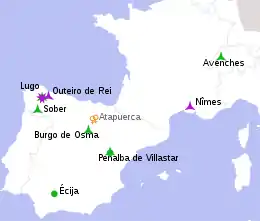
The majority of the known inscriptions dedicated to Lugus come from the Iberian Peninsula, perhaps indicating this deity's particular importance and popularity among the Iberian Celts.[21]
An inscribed lead plate found in Chamalières in France includes the phrase luge dessummiíis, which has been tentatively interpreted by some scholars as "I prepare them for Lugus", though it may also mean "I swear (luge) with/by my right (hand)".[22]
Toponyms and ethnonyms
His name was commemorated in numerous place-names, such as Lugdunum (Celtic *Lug[u]dūnon, "fort of Lugus"; modern Lyon, France), capital of the Roman province of Gallia Lugdunensis. Other such place-names include Lugdunum Clavatum (modern Laon, France[23]) and Luguvalium[24] (modern Carlisle, England). It is also possible that Lucus Augusti (modern Lugo in Galicia, Spain) is derived from the theonym Lugus,[25] but Lucus in that place may in fact be purely Latin (lucus = 'sacred grove/forest').
Other places which are likely named after him include:
- Loudun,[23] Ligueil,[23] and Montluçon in France;
- Loudoun in Scotland;[23]
- Dinlleu in Wales;
- Leiden in the Netherlands;[23]
- Lugones in Asturias, Spain (territory once inhabited by the Luggones Astur tribe);
- Legnica in Silesia;
- Lothian in Scotland;
- Luton in England.[26]
Ethnonyms which may derive from Lugus include the Luggones of Asturias,[27] and the Lougei, known from inscriptions in Lugo and El Bierzo.[21] Roman geographer Ptolemy wrote that the Lougonoi ("Lugoni"), also called Luggoni, were related to the Lougoi of Scotland.[28]
Gaulish Mercury
Julius Caesar in his De Bello Gallico identified six gods worshipped in Gaul, by the usual conventions of interpretatio romana giving the names of their nearest Roman equivalents rather than their Gaulish names. He said that "Mercury" was the god most revered in Gaul, describing him as patron of trade and commerce, protector of travellers, and the inventor of all the arts.[29] The Irish god Lug bore the epithet samildánach ("skilled in all arts"), which has led to the widespread identification of Caesar's Mercury as Lugus. Mercury's importance is supported by the more than 400 inscriptions referencing him in Roman Gaul and Britain.[13] Such a blanket identification is optimistic; Jan de Vries[30] demonstrates the unreliability of any one-to-one concordance in the interpretatio romana.[31]
Iconography
The iconography of Gaulish Mercury includes birds, particularly ravens and the cock, now the emblem of France; horses; the tree of life; dogs or wolves; a caduceus, or herald's staff topped with a pair of snakes; mistletoe; shoes (one of the dedications to the Lugoves was made by a shoemakers' guild; Lugus's Welsh counterpart Lleu (or Llew) Llaw Gyffes is described in the Welsh Triads as one of the "three golden shoemakers of the island of Britain"); and bags of money. He is often armed with a spear. He is frequently accompanied by his consort Rosmerta ("great provider"), who bears the ritual drink with which kingship was conferred (in Roman mythology). Unlike the Roman Mercury, who is typically a youth, Gaulish Mercury is occasionally also represented as an old man.It has also been speculated that the Irish Leprechaun shares the same root "Lu" prechaun and notably leprechauns were also often represented as shoemakers.[32]
Triplism
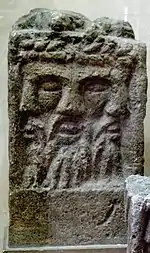
Gaulish Mercury is associated with triplism: sometimes he has three faces, sometimes three phalluses, which may explain the plural dedications. This also compares with Irish myth. In some versions of the story Lug was born as one of triplets, and his father, Cian ("Distance"), is often mentioned in the same breath as his brothers Cú ("Hound") and Cethen (meaning unknown), who nonetheless have no stories of their own. Several characters called Lugaid, a popular medieval Irish name thought to derive from Lug, also exhibit triplism: for example, Lugaid Riab nDerg ("of the Red Stripes") and Lugaid mac Trí Con ("Son of Three Hounds") both have three fathers.
Ludwig Rübekeil[33] suggests that Lugus was a triune god, comprising Esus, Toutatis and Taranis, the three chief deities mentioned by Lucan (who, at the same time, makes no mention of Lugus), and that pre-Proto-Germanic tribes in contact with the Celts (possibly the Chatti) moulded aspects of Lugus into the Germanic god Wōdanaz i.e. that Gaulish Mercury gave rise to Germanic Mercury.
Sacred sites
High places (Mercurii Montes), including Montmartre, the Puy-de-Dôme and the Mont de Sène, were dedicated to him.
Continuity in later Celtic narratives
In Ireland, Lugh was the victorious youth who defeats the monstrous Balor "of the venomous eye". He was the godly paradigm of priestly kingship, and another of his appellations, lámhfhada “of the long arm”, carries on an ancient Proto-Indo-European image of a noble sovereign expanding his power far and wide. His festival, called Lughnasadh ("Festival of Lugh") in Ireland, was commemorated on 1 August. When the Emperor Augustus inaugurated Lugdunum ("fort of Lugus", now Lyon) as the capital of Roman Gaul in 18 BC, he did so with a ceremony on 1 August (this may be coincidental, however, as this date also commemorates Augustus' victory over Cleopatra at Alexandria). At least two of the ancient Lughnasadh locations, Carmun and Tailtiu, were supposed to enclose the graves of goddesses linked with terrestrial fertility.
Lugus has also been suggested as the origin not only of Lugh and Lleu Llaw Gyffes, but also the Arthurian characters Lancelot and Lot (most famously championed by the Arthurian scholar Roger Sherman Loomis), though more recent Arthurian scholarship has downplayed any such link between Lugus and Lancelot.
See also
Notes
- Bas-relief discovered in Paris in 1867 and preserved at the Carnavalet Museum, from J.-L. Courcelle-Seneuil, Les Dieux gaulois d'après les monuments figurés (The Gallic Gods According to the Figurative Monuments), Paris, 1910.
- Julius Pokorny, Zeitschrift für Celtische Philologie, 21, 1940, 114f.
- Julius Pokorny, Indogermanisches Etymologisches Wörterbuch, Francke, 1959, 686.
- Bernard Mees, Celtic Curses, Boydell & Brewer, 2009, p. 45.
- H. Wagner, Studies in the Origins of early Celtic Civilisation, Zeitschrift für Celtische Philologie, 31, 1970, p. 24.
- Peter Schrijver, Studies in British Celtic historical phonology, Rodopi, 1995, pp. 348-348
- Lejeune, Michel, Celtibérica, Universidad de Salamanca, 1997, pp. 8ff.
- Koch, John, Celtic Culture: a historical encyclopedia, ABC-CLIO, 2006, p.
- CIL XIII, 05078
- Corpus Inscriptionum Latinarum, Vol. 2, Walter de Gruyter, 1974, p. 387, inscription 2818.
- Gruffydd, William John. Math vab Mathonwy, University of Wales Press, 1928, p. 238.
- Gruffydd, William John. Math vab Mathonwy, University of Wales Press, 1928, pp. 237ff.
- Alexei Kondratiev, "Lugus: the Many-Gifted Lord", An Tríbhís Mhór: The IMBAS Journal of Celtic Reconstructionism #1, 1997
- AE 2003, 952
- IRPL, pp. 80-89.
- ILER, p. 868.
- IRPL, pp. 87-88.
- ILER, p. 869.
- Abad, Rubén Abad. (2008). "La divinidad celeste/solar en el panteón céltico peninsular". In: Espacio, Tiempo y Forma. Serie II, Historia Antigua, 21: 101.
- CIL XII, 3080
- Francisco Marco Simón, "Religion and Religious Practices of the Ancient Celts of the Iberian Peninsula", E-Keltoi Vol 6, 2007
- Lugus: The Gaulish Mercury Archived 2005-03-06 at the Wayback Machine at Mabinogion.info. P.-Y. Lambert leaves this phrase partially untranslated, Que tu ... à ma droite ("May you ... to my right"), cited at L'Arbre Celtique.
- Xavier Delamarre (2003). Dictionnaire de la langue gauloise. Éditions Errance. p. 210. ISBN 2-87772-237-6.
- The usual emended spelling Luguvallium appears to be wrong, according to Kenneth Jackson, ("On Some Romano-British Place-Names" The Journal of Roman Studies 38.1 and 2 (1948, pp. 54-58) p 57), offering Bede's Lugovalium, as "Town of Lugovalos", that is, "those strong as Lugos", accepted by A.M. Armstrong, et al. The Place-Names of Cumberland, (Cambridge University Press) 1950-53.
-
- García Quintela, Marco V. (et al.) "Souveraineté et sanctuaires dans l'Espagne celte. Études comparées d'historie et d'Archéologie. Memoires de la Societé Belge d'Etudes Celtiques 17 (2003) (Brussels)
- J.E.B. Glover, Allen Mawer, F.M.Stenton (1938). The Place-Names of Hertfordshire. English Place-Name Society, vol. XV. Cambridge University Press.CS1 maint: multiple names: authors list (link)
- Inscription on stone: "Asturum et Luggonum" found in Piloña, Asturias, early Astur-Roman period. The stone is now in the Archaeological Museum of Asturias in Oviedo.
- Abad, Rubén Abad. (2008). "La divinidad celeste/solar en el panteón céltico peninsular". In: Espacio, Tiempo y Forma. Serie II, Historia Antigua, 21: 101.
- Julius Caesar, Commentarii de Bello Gallico 6.17
- Jan de Vries, Celtisches Religion (Stuttgart: Kohlhammer Verlag) 1961, pp 40-56.
- Peter Buchholz, "Perspectives for Historical Research in Germanic Religion" History of Religions 8.2 (November 1968, pp. 111-138) p 120 and note.
- 2001. Celtic Heroes,Changelings', and the Mothers. (37), pp.93-116.
- Rübekeil, Ludwig. Wodan und andere forschungsgeschichtliche Leichen: exhumiert, Beiträge zur Namenforschung 38 (2003), 25–42.
References
- AE = L'Année épigraphique
- CIL = Corpus Inscriptionum Latinarum, Vol XIII: Inscriptiones trium Galliarum et Germaniarum Latinae; Vol II: Inscriptiones Hispaniae Latinae.
- ILER = Inscripciones Latinas de la España Romana
- IRPL = Inscriptions Romaines de la Province de Lugo
- Recueil des Inscriptions Gauloises [RIG], Tome 1: Textes gallo-grecs (CNRS, Paris, 1985)
- Ellis, Peter Berresford, Dictionary of Celtic Mythology(Oxford Paperback Reference), Oxford University Press, (1994): ISBN 0-19-508961-8
- Stifter, David, "Celtiberian -unei, Luguei", Die Sprache, 39/2 (2000 [1997]), 213–223.
External links
 Media related to Lugus at Wikimedia Commons
Media related to Lugus at Wikimedia Commons
